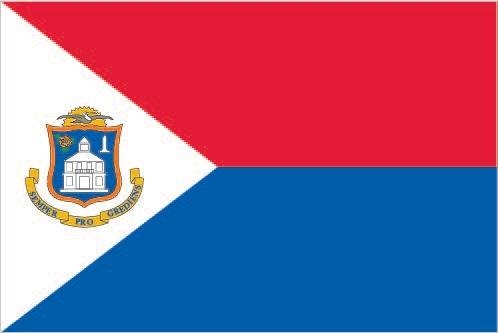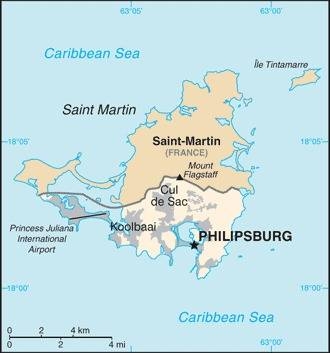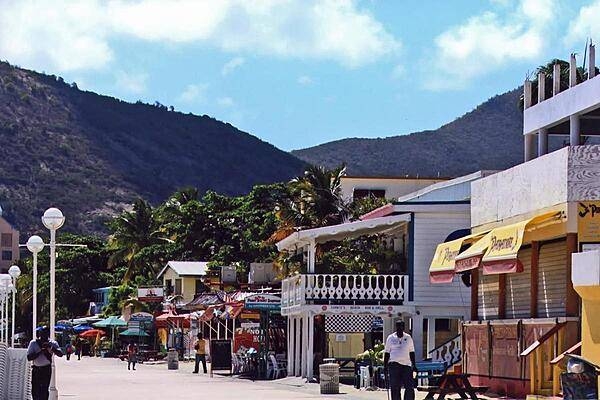99 Sint Maarten (Netherlands)

Two equal horizontal bands of red (top) and blue with a white isosceles triangle based on the hoist side. The center of the triangle displays the Sint Maarten coat of arms. The arms consist of an orange-bordered blue shield prominently displaying the white court house in Philipsburg, as well as a bouquet of yellow sage (the national flower) in the upper left, and the silhouette of a Dutch-French friendship monument in the upper right. The shield is surmounted by a yellow rising sun in front of which is a brown pelican in flight. A yellow scroll below the shield bears the motto: SEMPER PROGREDIENS (Always Progressing). The three main colors are identical to those on the Dutch flag.
Flag courtesy of the CIA World Factbook

Map courtesy of the CIA World Factbook

Colorful shops along a street in Philipsburg, the capital of Sint Maarten.
Photo courtesy of the CIA World Factbook
Last updated on October 24, 2025
Government
According to Britannica, the Arawak and Carib inhabited the island before its sighting by Christopher Columbus on November 11, 1493, the feast day of St. Martin of Tours. It was claimed by several European powers, notably the Dutch and the French, who partitioned the island in 1648. The Dutch portion of the island became a part of the Dutch West Indies in 1828 and in 1845 was one of the six Dutch island territories in the West Indies that were brought under collective administration. In 1954 those six were reorganized into the Netherlands Antilles, becoming an integral part of the Netherlands politically with autonomy in their internal affairs. However, in 1986 one of the constituent members, Aruba, chose to leave the Netherlands Antilles and establish its own autonomy within the Kingdom of the Netherlands.
In 1989 the political leadership of Sint Maarten announced its desire to achieve full independence as soon as possible, although eventually Sint Maarten chose to remain within the Netherlands with a status that allowed for a greater degree of autonomy. In 2006 the people of Sint Maarten agreed, along with the other islands and the government of the Netherlands, to dissolve the Netherlands Antilles; this occurred on October 10, 2010. Sint Maarten and Curaçao became, like Aruba, countries within the Kingdom of the Netherlands.
The head of state is the Dutch monarch, represented by a governor, and the head of government is the prime minister. A Council of Ministers, presided over by the prime minister, forms government policy. A minister plenipotentiary from Sint Maarten resides in the Netherlands and represents the country there at meetings of the Netherlands Council of Ministers. Sint Maarten has a unicameral Parliament (Staten), with 15 members (subject to increase up to 21 members, depending upon population growth) elected on the basis of proportional representation for a term of four years. Voting is open to all residents of Sint Maarten with Dutch nationality who are at least 18 years old. Sint Maarten is independent in internal affairs, but the government of the Netherlands is responsible for defense, foreign relations, and similar external matters. The judiciary consists of a Court of First Instance and a Common Court of Justice of Aruba, Curaçao, Sint Maarten and Bonaire, Sint Eustatius and Saba, both of which handle civil and criminal cases. The Supreme Court of the Netherlands is the court of final appeal.
Department of Civil Aviation Shipping and Maritime Affairs
Department of Civil aviation Shipping and Maritime Affairs
- advise on matters concerning airport, and on companies that provide transport and telecommunication services
- responsibility of policy, laws and legislation concerning the Aviation, as well as the supervision of the implementation of this
- coordinating the Aviation Policy with other ministries, the administrative authorities of the other kingdom partners, independent governing bodies and private agencies whose activities have interfaces with that policy
- manage political and economic aviation affairs of St. Maarten within the Kingdom, internationally and regionally
- management of the Aviation register of St. Maarten
- responsibility for supervision of the compliance with the laws and legislation and international treaties, as well as on the aero technical and operational activities of governments and private agencies in the area of Aviation
Airspace
SkyVector – Google Maps – ADS-B Exchange
ICAO countries publish an Aeronautical Information Publication (AIP). This document is divided into three parts: General (GEN), En Route (ENR) and Aerodromes (AD). ENR 1.4 details the types of airspace classes they chose to adopt from classes A through G.
Drone Regulations
Use of UAS/RPAS or Drones prohibited from no fly zones – 2020
Advanced Air Mobility (AAM) Regulations & Policies
None found by the author.
However, should you, the reader, happen to stumble across something to the contrary, please email the author at FISHE5CA@erau.edu and you may be mentioned in the ACKNOWLEDGEMENTS section of this book by way of thanks for contributing to this free eBook!
Advanced Air Mobility (AAM) News
None found by the author.
However, should you, the reader, happen to stumble across something to the contrary, please email the author at FISHE5CA@erau.edu and you may be mentioned in the ACKNOWLEDGEMENTS section of this book by way of thanks for contributing to this free eBook!
Short Essay Questions
Scenario-Based Question
You have been hired by a Drone Startup Company. Your boss has immediately assigned this job to you.
They need you to prepare a one-page memo detailing the legalities of using a drone to film in Sint Maarten, pictured above.
They need you to mention any national laws and local ordinances.
They specifically want to know what airspace (insert pictures) you will be operating in and whether or not you need an airspace authorization.
Does it matter whether or not you are a citizen of the country?
Lastly, there is a bonus for you if, as you scroll through this chapter, you find any typos or broken links!
Short Essay Questions
- What are the drone categories?
- How is registration addressed?
- How is remote ID addressed?
- What are the model aircraft rules?
- What are the commercial drone rules?
- Are there waivers or exemptions to the rules? If so, for what?
- Would you share a link to an interactive airspace map?
- How is BVLOS addressed?
- How can you fly drones at night?
- How can you fly drones over people?
- Where do you find drone NOTAMs?
- What are the rules for drone maintenance?
- What are the rules for an SMS program?
- What are some unique rules not mentioned above?
- What are the C-UAS rules?
- What are the AAM rules?

